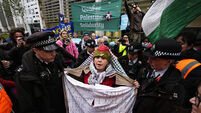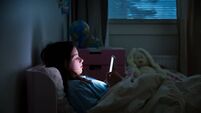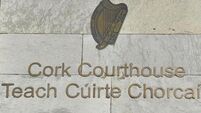Master of the black arts ...
DUBH: Dialogues in Black is an exhibition of objects that reference the colour black. The show is in The Oliver Sears Gallery, Dublin.
The exhibition first ran at the American Irish Historical Society, on Fifth Avenue in New York, last October and November. The project was conceived by Studio Practice, under the direction of Joseph Walsh, the furniture designer based in Riverstick, Co Cork, and curated by Brian Kennedy. Dubh is the second of three shows organised by Studio Practice, a non-profit agency that supports Irish artists, craft persons, and designers in building relationships internationally.
“Dubh: Dialogues in Black was part of the 2011 Imagine Ireland programme,” says Nuala O’Donovan, whose ceramics features in the show. “Imagine Ireland showcased arts from Ireland all over the United States; a broad range of theatre, dance, music, as well as a range of visual art practices. It was really to try and present a different image of Ireland as a cultural entity.”
Kennedy considered black as a physical and an emotional starting point. He invited Irish practitioners, from Material Poetry, the 2010 exhibition he worked on with Studio Practice, and American counterparts. Kennedy is known for his fresh approach in selecting shows and developing markets for Irish work internationally.
“Maybe because he’s a fine artist, Brian is looking at work and saying, ‘should we stretch the boundaries a little bit?’,” says O’Donovan. “There’s work being made that’s quite interesting but it’s not shown because it doesn’t fit into a particular category, so it’s quite difficult to have galleries stimulate or create an interest in it. What this exhibition does is very valuable that way, because it puts work together that you wouldn’t normally see together and it exposes work to new audiences.”
O’Donovan does not usually employ the colour black. “Brian knew my work from Material Poetry, and when I was showing in Ceramic Art London, last year, I had grid pieces and he was quite interested in them and he asked me to try them out in black. They were quite successful. It was a much more laborious process, as you have to stain the clay and it takes a lot of time. From beginning to end, most pieces would take me two months to do. That’s not really counting the research part of it. With the grid pieces, I would decide beforehand exactly what they’re going to be like, because I have to make the pieces to an exact size. I’d fire everything at least twice. I think it makes them a bit stronger, though I don’t know if that’s just a superstition I have myself. With the black pieces, I took them a bit higher in the second firing as the black becomes a bit blacker. Then I changed it a bit, I removed some sections, sanded it off and fired it again.
“I haven’t used colour before because I’m interested in geometry and symmetry and pattern, and I felt like that was such a huge area; if you started adding colour in, it changes people’s perception of the pieces.”
O’Donovan is a native of Cork city but has travelled through work and education. An architectural technician course in CIT, followed by interiors training in Dublin, set her up for a career in design, which she practised in the UK, USA and Australia. Interested in paring back her focus to the fundamentals of design, O’Donovan undertook a degree in three-dimensional design at Middlesex University. Back in Ireland, she concentrated on ceramics full-time.
“I don’t know if it’s something that happens when you get into your 40s and you say, ‘right, okay, I’ve got to make a decision now’. So I did the post-diploma year in the ceramics department in the Crawford College of Art and Design in Cork. I did the masters in ceramics after that. I finished in 2008 and I’ve been working in ceramics ever since,” she says.
Catherine Owens is an artist with one ‘foot’ on either side of the Atlantic. Born in Dublin, she graduated from Belfast College of Art before heading for New York, her base for 25 years, though she keeps a house and studio in Co Waterford. Owens met Kennedy in her third year of college on a reciprocal with the Crawford College of Art, where Kennedy lectured in the print department.
“Over the years, I reconnected with him,” says Owens. “I also know his brother, John Kennedy, as he used to tour manage U2.” Owens has been U2’s art director for many of their tours, as well as their music videos. It was through this work that she developed the LED drawings exhibited in Dubh: Dialogues in Black.
“I’m working with Tommy Voeten, a technology developer for lighting design,” says Owens. “We both worked on the last U2 tour together, where we started talking about the experimental work I wanted to do. We’ve been working over the last two years, and these drawings in the show are a result of that.
“My default button is pencil-on-paper and so I wanted to go back into the studio and go in with pencil as far as I could go, where my mind wasn’t part of the conversation, it was just my eyes and my hand. I took a couple of months and turned things off. I have a little studio in upstate New York, where I work, and I basically lock myself in with public radio. Me and public radio. And I just got into a real groove with these drawings,” she says.
Owens took her drawings to Voeten with the notion of housing them in frames that would also be part of the work. “The frames would have an LED component that would wash over the drawing, almost like watercolour seeping through the pencil work,” she says. “It would be motion-sensored so you wouldn’t see it necessarily, but then, as you’re moving past, the drawing begins to illuminate. It’s a little bit of smoke and mirrors, in terms of really wanting to create something that had depth and a different kind of perception to what you were feeling when you first looked at it.”
Owens and Voeten designed a frame they could produce on a 3D printer.
“Inside the frame is housed a computer chip that programmes this one, little LED bulb. That programming can be anything — any colour, any multiples of colour, any speed. You could effectively run video content through the computer chip, and obviously you would just get movement of colour and shape. But it’s a very nice combination of materials, of traditional arts materials and modern technology,” she says.
Owens says the works also relate to art history in their reference to the illuminated haloes in the paintings of the Italian master Fra Angelico. “It’s a look at the meaning of the halo in his work and really putting a very modern interpretation on that.
“I do feel that when you’re in the room with these drawings, you feel like you’re with something living. The pulsing of the colour on these particular four pieces is really related to breath and quite slow-breathing. So you do feel like there’s something in the room with you.
“There is a sense of that otherness from that world of the haloes,” she says.
Until Mar 16; www.oliversearsgallery.com

















